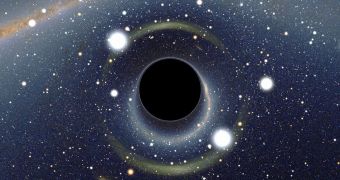A collaboration of European researchers has recently been awarded a new grant for developing the equipment and technologies necessary to image a black hole. These structures, believed to be of infinite density, have never been observed directly due to the fact that they engulf all light around them.
The vast majority of astrophysicists and astronomers are convinced that black holes are real, based on the effects they have on their surroundings, particularly at the cores of galaxies such as the Milky Way.
However, no one has been able to clearly demonstrate that such structures exist. The purpose of the BlackHoleCam initiative is to change that by producing the first-ever image of a black hole, and of its event horizon, the theorized limit beyond which nothing can escape its gravitational pull.
Scientists say that the event horizon is a hypothetical limit around any black hole, past which the object exerts such a massive gravitational influence that nothing, not even light, can escape it. Matter and radiation that pass this limit fall into the black hole, feeding its growth.
But all explanations will remain nothing more than hypotheses until clear evidence can be produced to support the black hole theory. This is why the European Research Council has recently awarded astrophysicists a €14 million ($19.3 million) grant to create a photograph of such a structure.
The team's first target will most likely be Sagittarius A*, the supermassive black hole powering up the core of our galaxy, the Milky Way. “While most astrophysicists believe black holes exist, nobody has actually ever seen one,” explained Radboud University Nijmegen astrophysicist Heino Falcke.
The expert, one of the three principal investigators on BlackHoleCam, made the announcement in a statement published on Tuesday, December 17. “The technology is now advanced enough that we can actually image black holes and check if they truly exist as predicted,” he added.
“If there is no event horizon, there are no black holes,” Falcke said. The European research team plans to use a technique called Very Long Baseline Interferometry (VLBI) to photograph the black hole and its event horizon. It is currently estimated that Sagittarius A* is 4 million times heavier than the Sun.
“Einstein’s theory of general relativity is the best theory of gravity we know, but it is not the only one. We will use these observations to find out if black holes, one of the most cherished astrophysical objects, exist or not,” adds BlackHoleCam principal investigator Luciano Rezzolla, who is based at the Goethe University, in Frankfurt, Germany
The research team plans to use VLBI to tie together a number of radio observatories around the world, including the newly-commissioned Atacama Large Millimeter/submillimeter Array (ALMA), in Chile, Space reports.

 14 DAY TRIAL //
14 DAY TRIAL //